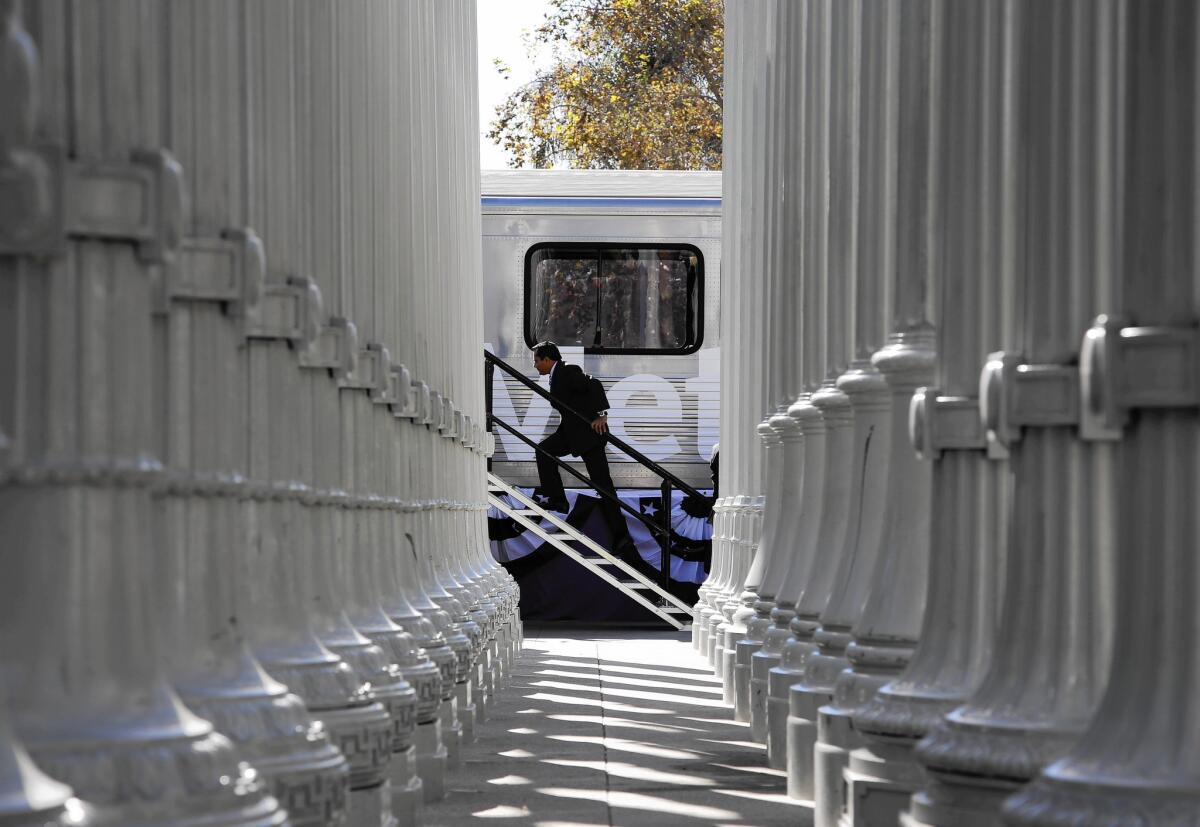L.A.’s not-quite ‘subway to the sea’ finally breaks ground

More than 30 years ago, officials promised that Los Angeles’ first modern subway would cut through the congested and heavily populated Wilshire Corridor connecting downtown to the city’s coastal suburbs.
Now, after decades of delay over safety and environmental concerns, court battles and congressional debate, construction is finally beginning on the first phase of what former Mayor Antonio Villaraigosa promoted as the “Subway to the Sea.”
But the multibillion-dollar Purple Line extension celebrated by political leaders at a Friday groundbreaking won’t fully deliver on past promises. The line will most likely end at the Veterans Administration hospital in Westwood, miles from the ocean. And even if all goes well, getting that far will take an additional 20 years.
Still, many planners and public officials said the region would finally realize benefits of what should have been L.A.’s highest mass transit priority.
Wilshire Boulevard “is the most promising corridor in Los Angeles for rail rapid transit. It has always ranked at the top” and is long overdue, said Martin Wachs, a former transportation expert at the Rand Corp. now at UCLA.
During ceremonies at the Los Angeles County Museum of Art, local, state and federal officials predicted that the first 3.9-mile, $2.8-billion leg of the new line will accelerate a regional transportation renaissance, adding an important incentive to lure commuters from their cars.
“This is a historic day for the Westside, which has not been served by rail transit since the Pacific Red Cars,” said Los Angeles County Supervisor Zev Yaroslavsky, a member of Metro’s board. “This is the right corridor in the right place and, hopefully, at the right time.”
The initial section of tunnel will carry passengers from a station at Wilshire and Western Avenue, near downtown, to La Cienega Boulevard in the Miracle Mile, once a symbolic hub of L.A.’s car culture.
Stations will be included at La Brea Avenue and Fairfax Avenue. Two later phases are expected to push the line five additional miles to Westwood at a cost of at least $3.5 billion.
Although Villaraigosa and other elected officials talked of a “subway to the sea,” that proved to be more slogan than reality. Metro officials have stressed that extending the Purple Line to the coast would add billions of dollars to the line’s cost.
Instead, Marc Littman, a Metro spokesman, said the Expo light-rail service, which parallels the subway route, eventually will reach Santa Monica, with a stop a few blocks from the beach.
The first Purple Line segment is being financed with a $1.2-billion grant and an $856-million loan from the federal government. The balance will come from Measure R, the county’s voter-approved half-cent sales tax for transportation projects.
When the entire subway is completed, officials say riders will get from downtown to Westwood in about 25 minutes and gain easy access to many Mid-City and Westside residential areas, commercial centers and cultural attractions.
The Purple Line is expected to boost average weekday ridership on the subway system by more than a third, to about 215,000 daily boardings.
“This will help people get to where they need to go, cut traffic and boost the economy,” said Los Angeles Mayor Eric Garcetti.
Progress on the subway extension came to a halt in the mid-1980s after methane gas leaked from the ground and exploded in a Fairfax clothing store.
The blast contributed to a 22-year delay of the project, after the area’s congressman, Rep. Henry Waxman, sponsored successful legislation banning the use of federal money for the subway’s western extension.
Ultimately, a team of tunneling and transportation experts concluded that the line could be safely built because of improvements in boring machines and construction techniques. Waxman won a repeal of the funding ban in 2007.
Brian Taylor, a transportation expert and urban planning professor at UCLA, said that despite improvements in tunneling, construction of the line will be complicated by webs of utility lines, old oil fields, pockets of gas and seismic conditions.
He also questioned whether the $600-million- to $700-million-a-mile cost of the Purple Line could benefit more people if it were spent elsewhere on less expensive transit improvements.
Though officials say the Purple Line will reduce Westside traffic, the project’s environmental analysis indicates there will be only limited relief on Wilshire and nearby surface streets and little or no relief for the area’s freeways.
Metro officials argue that traffic relief will occur as more subway and light-rail lines are added and linked together, making longer, single-train trips possible.
At Friday’s ceremonies, Santa Monica Mayor Pam O’Connor predicted the Westside subway will encourage a significant shift away from the automobile.
“If the car is king of L.A.,” she said, “then the Purple Line will be the queen of L.A.”
O’Connor added that she remained optimistic about the project reaching the coast. “I’m still hopeful about the subway to the sea,” she said. “Maybe after 2035.”
Follow @LADeadline16 for transportation news
More to Read
Sign up for Essential California
The most important California stories and recommendations in your inbox every morning.
You may occasionally receive promotional content from the Los Angeles Times.











